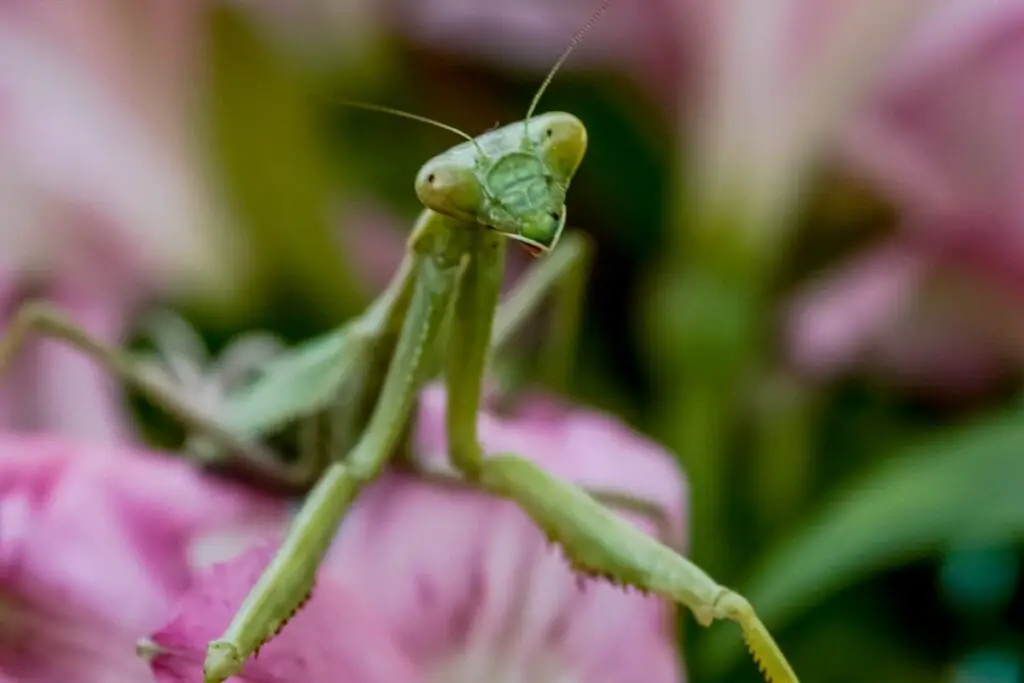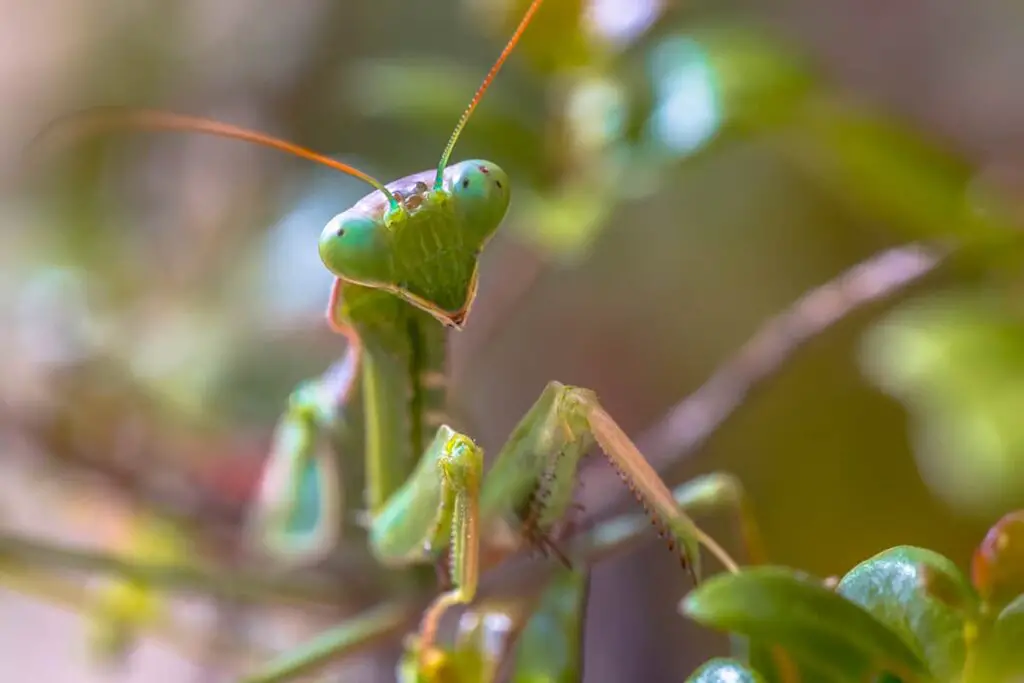Creating an ideal indoor habitat for your praying mantis is essential for its survival and well-being. You’ll need a secure enclosure that mimics the creature’s natural environment to keep your mantis healthy and happy. This setup ensures that your mantis has adequate space to move, molt, and feed properly.
When setting up your indoor mantis habitat, think about the essentials: lighting, temperature, humidity, and the space your mantis needs to thrive. Remember, the enclosure should typically be at least three times the length of the mantis and twice as wide, providing ample room for climbing and exploring. Your mantis will also need proper ventilation to maintain air circulation and prevent stagnant conditions.
Your praying mantis habitat should include a mix of sticks and foliage to resemble its natural surroundings, creating an environment that not only meets its physical needs but also encourages natural behaviors. By attending to these details, you will give your pet mantis a comfortable and nurturing space to live in.
Choosing the Right Habitat
Creating an indoor habitat for your praying mantis is an important step in ensuring its health and longevity. The right habitat will mimic a mantis’s natural environment while also being practical for in-home care.
Tank Size and Shape
Your praying mantis requires a space where it can move freely, so choosing a tank that’s approximately three times longer than the mantis’s body length and twice its width is ideal. Tall enclosures are preferable because mantises like to climb and need space to molt properly.
Substrate Selection
Selecting the right substrate is essential for your mantis’s footing and health. A layer of peat moss, coconut fiber, or soil works well. Ensure the substrate is free of chemicals and pesticides and is kept slightly damp to support their needs.
Temperature and Humidity Levels
Maintaining optimal temperature and humidity levels in the habitat is critical. Aim for temperatures between 75-85°F with humidity levels at 50-70%. Use a humidity gauge to monitor levels and mist the enclosure as necessary to maintain the proper conditions.
Setting Up the Habitat
Creating an ideal environment for your praying mantis requires careful attention to heating, foliage arrangement, and ensuring there are adequate hiding spots. Here’s how you can establish a suitable habitat for your mantis to thrive in.
Installation of Heating Elements
To maintain a consistent temperature within your praying mantis habitat, you’ll need to install a heating element. Ideally, the habitat should stay at a temperature between 75°F and 85°F during the day and slightly cooler at night. You can achieve this by placing a heating pad under one side of the enclosure or installing a low-wattage heat lamp above it, allowing for a temperature gradient.
Positioning the Foliage
Incorporate live plants or artificial foliage into the habitat to mimic the mantis’s natural environment. Arrange the leaves and branches to provide multiple perching levels and ensure they are securely fastened so they do not collapse under your mantis’s weight. The foliage should be placed such that there is space for the mantis to move freely.
Creating Hiding Places
Your mantis will need spaces to hide and feel secure. This can be accomplished with hollow bark, cork rounds, or flower pots turned on their sides. Space these hiding places strategically throughout the enclosure to give your mantis a sense of safety and seclusion, which is essential for their well-being.
Mantis Care Basics
Creating a proper habitat and knowing the essentials of mantis care will ensure your praying mantis remains healthy and content. Let’s look at the basic requirements for feeding, molting, and health monitoring.
Feeding Your Mantis
Your mantis needs a diet of live insects, such as flies or crickets. Offer prey that is smaller than your mantis to avoid injury. You should feed young mantises every day and adult mantises every 2-3 days.
Molting and Growth
Molting is critical for a mantis’s growth. Ensure your habitat has enough vertical space for your mantis to hang upside down. After molting, avoid handling your mantis until its exoskeleton hardens.
Health Monitoring
Regularly check for signs of stress like lack of appetite or lethargy. Create a suitable environment to prevent health issues, and address any abnormal behaviors promptly.
Frequently Asked Questions
When setting up a praying mantis habitat, it’s important to consider their specific needs to ensure they thrive in captivity. From the enclosure to decoration, this guide will help you address key aspects of habitat setup.
What are the essential items needed for a praying mantis enclosure?
Your praying mantis enclosure needs to be secure and have room for movement and growth. Essential items include a container, proper ventilation, a substrate, and branches or plants for climbing and molting.
How can I maintain proper humidity and temperature in my mantis habitat?
Maintain humidity by misting the habitat regularly and ensure the temperature stays within 70-85°F. Monitor conditions with a hygrometer and thermometer.
Can you provide tips for decorating a praying mantis habitat for optimal health?
Add live or artificial plants and branches, which not only mimic a natural environment but also facilitate molting. Avoid overcrowding the space to reduce stress.
What is the ideal size for a praying mantis enclosure?
The enclosure should be at least three times the length and twice the width of your mantis. This space requirement allows for adequate movement and molting.
How often should I clean my praying mantis habitat and what’s the best way to do it?
Clean the habitat every two to four weeks. Remove waste, uneaten food, and shed exoskeletons, and periodically replace the substrate to prevent mold and bacteria growth.
Are there specific dietary needs I should consider when feeding my praying mantis?
Praying mantises are carnivorous and need a diet of live insects like flies, crickets, or moths. Young mantises require smaller prey, while adults can handle larger insects. Feed them every 2-3 days.
Driven by a passion for those tiny creatures that rule our world, we at Bug Domain strive to be your go-to resource for information on insects.




